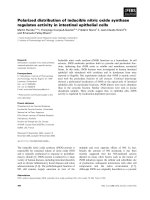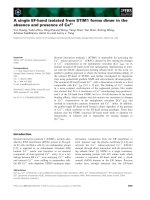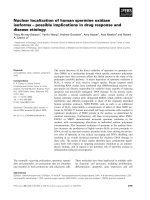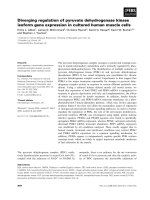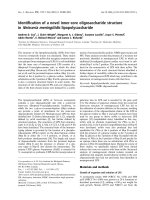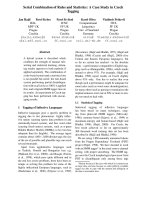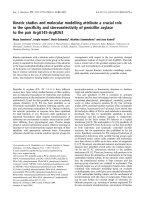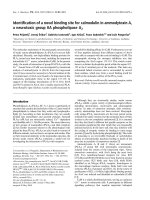Báo cáo khoa học: "Water relations of European silver fir (Abies alba Mill) in 2 natural stands in the French Alps subject to contrasting climatic conditions" pps
Bạn đang xem bản rút gọn của tài liệu. Xem và tải ngay bản đầy đủ của tài liệu tại đây (743.53 KB, 13 trang )
Original
article
Water
relations
of
European
silver
fir
(Abies
alba
Mill)
in
2
natural
stands
in
the
French
Alps
subject
to
contrasting
climatic
conditions
P
Guicherd
Université
Joseph-Fourier,
Centre
de
Biologie
Alpine,
BP
53, 38041
Grenoble
cedex
9,
France
(Received
30
November
1992;
accepted
26
January
1994)
Summary —
This
paper
reports
on
the
diurnal
and
seasonal
variations
in
water
potential,
stomatal
con-
ductance,
and
transpiration
of
twigs
from
silver
fir
in
a
mesohygrophilic
stand
of
the
external
French
Alps,
and
in
a
mesoxerophilic
stand
in
the
inner
French
Alps
where
this
fir
grows
near
its
ecological
limits.
In
both
stands,
predawn
needle
water
potential
was
always
0.2-0.4
MPa
below
the
potential
of
the
driest
soil
layer.
In
the
first
one,
it
was
maintained
at
about
-0.4
MPa.
Maximum
stomatal
conduc-
tance
and
maximum
transpiration,
which
could
reach
200
mmol/m
2
/s
and
1
mmol/m
2
/s,
respectively,
occurred
at
the
same
time
which
corresponded
to
minimum
leaf
water
potential.
In
the
dry
stand,
predawn
needle
water
potential
never
dropped
below
-1.14
MPa,
yet
a
general
browning
of
older
needles
was
already
observed.
The
decrease
of
predawn
needle
water
potential
was
accompanied
by
the
decrease
of
maximum
stomatal
conductance
and
transpiration
to
15%
of
their
highest
value,
which
reached
150
mmol/m
2
/s
and
1
mmol/m
2
/s,
respectively,
at
this
stand.
Maximum
stomatal
conduc-
tance
occurred
in
general
before
UT
07.00,
and
maximum
transpiration
5-6
h
later,
irrespective
of
predawn
needle
water
potential.
Furthermore,
in
both
stands,
stomata
closed
at
vapor
pressure
deficit
value
as
low
as
0.3
kPa.
This
extremely
early
reaction
to
water
stress
exhibited
by
European
silver
fir
is
consistent
with
its
well-known
sensitivity
to
atmospheric
humidity
and
soil
water
availability.
It
indi-
cates
a
strong
avoidance
strategy,
which
we
have
hitherto
attributed
only
to
species
better
adapted
to
drought.
Abies
alba
Mill
=
European
silver
fir
/ Alps
/ stomata
/ water
potential
/ water
deficit
Abbreviations
and
units:
E
=
transpiration
(mmol
(H
2
O)/m
2
/s);
E
max
=
maximal
transpiration
(mmol
(H
2
O)/m
2
/s);
Gs
=
stomatal
conductance
(mmol(H
2
O)/m
2
/S);
G
smax
=
maximal
stomatal
conductance
(mmol(H
2
O)/m
2
/s);
Lp
=
soil-to-leaf
hydraulic
conductance
(mmol/m
2
/s/-MPa);
PFD
=
photon
flux
density
(μE/m
2
/s);
VPD
=
vapor
pressure
deficit
(kPa);
ψ
I
=
leaf
water
potential
(MPa);
y
Imin
=
minimum
leaf
water
potential
(MPa);
ψ
p
=
predawn
needle
water
potential
(MPa);
ψ
s
=
soil
water
potential
(MPa);
Δψ
=
ψ
Imin
-
ψ
p
(MPa).
Résumé —
Comportement
hydrique
du
sapin
pectiné
(Abies
alba
Mill)
dans
2
stations
des
Alpes
françaises
climatiquement
contrastées.
L’article
décrit les
variations
diurnes
et saisonnières
du
potentiel
hydrique
foliaire,
de
la
conductance
stomatique
et
de
la
transpiration
de
rameaux
de
sapin
dans
une
station
mésohygrophile
des
Alpes
externes,
et
dans
une
station
mésoxérophile
des
Alpes
internes
en
limite
écologique
de
l’essence.
Dans
les
2
stations,
le
potentiel
hydrique
de
base
est
tou-
jours
inférieur
de
0,2
à
0,4
MPa
au
potentiel
hydrique
des
couches
de
sol
les
plus
sèches.
Dans
la
pre-
mière,
il
s’est
maintenu
aux
environs
de
-0,4
MPa.
La
conductance
stomatique
et
la
transpiration
maximales,
pouvant
atteindre
respectivement
200
mmol/m2/s
et
1
mmol/m
2
/s,
ont
toujours
eu
lieu
au
même
moment,
qui
correspondait
au
potentiel
hydrique
foliaire
minimum.
Dans
la
station
sèche,
le
potentiel
hydrique
de
base
n’est jamais
descendu
en
dessous
de
-1,14
MPa,
mais
on
pouvait
déjà
obser-
ver
un
brunissement
généralisé
des
plus
vieilles
aiguilles.
Cette
diminution
du
potentiel
de
base
s’est
accompagnée
d’une
diminution
de
la
conductance
et
de
la
transpiration
maximales
pour
atteindre
15%
de
leur plus
forte
valeur,
qui
pour
cette
station
sont
respectivement
de
150
mmol/m2/s
et
1
mmol/m
2
/s.
La
conductance
stomatique
maximale
a
le
plus
souvent
eu
lieu
avant
7
h
TU,
et
la
trans-
piration
maximale
5
ou
6
h
après,
indépendamment
du
potentiel
de
base.
De
plus,
dans
les
2
sta-
tions,
les
stomates
se
ferment
quand
le
déficit
de
pression
de
vapeur
atteint
seulement
0,3
kPa.
Cette
réaction
extrêmement
précoce
au
stress
hydrique
est
cohérente
avec
la
légendaire
sensibilité
du
sapin
à
l’humidité
atmosphérique
ainsi
qu’à
l’eau
dans
le
sol.
Elle
dénote
chez
cette
essence
une
nette
stratégie
d’évitement
que
l’on
croyait
jusqu’alors
être
l’apanage
d’espèces
mieux
adaptées
à
la
sécheresse.
Abies
alba
Mill
= sapin
pectiné
/ Alpes
/ stomates
/ potentiel
hydrique
/ déficit
hydrique
INTRODUCTION
European
silver
fir
is
one
of
the
most
impor-
tant
forest-trees
in
France,
covering
one-
million
hectares
(Jacamon,
1987).
Our
understanding
of
its
ecological
amplitude
is
essentially
based
on
the
study
of
its
nat-
ural
range;
this
conifer
cannot
tolerate
late
frosts
and
dry
summers
and
is
the
major
component
of
mountain
forests
(900
to
1
500
m
of
elevation)
where
atmospheric
humidity
is
high.
Dendrochronological
and
dendro-ecological
studies
emphasize
the
high
sensitivity
of
silver
fir
to
water
stress
(Bîndiu,
1971;
Serre-Bachet,
1986;
Levy
and
Becker,
1987;
Becker,
1989)
while
experiments
on
young
potted
trees
show
that
it
conserves
water
quite
well
(Becker,
1970,
1977)
and
in
particular
better
than
Norway
spruce
(Picea
excelsa
Link)
with
which
it
is
frequently
mixed
in
mountain
stands.
However,
silver
fir
appears
to
delay
the
regulation
of
its
water-vapor
exchanges,
which
classifies
it
among
species
that
are
poorly
adapted
to
drought
(Aussenac,
1980).
In
the
French
Alps,
fir
forests
grow
from
the
very
humid
external
belt
to
the
most
xeric
areas
of
the
internal
one.
All
along
this
transect
of
increasing
continentality,
changes
in
climatic
conditions
modify
floris-
tic
composition
and
decrease
productivity
(Oberlinkels
et
al,
1990).
How
does
this
species,
which
is
believed
to
display
a
low
plasticity
in
its
response
to
environmental
conditions,
survive
and
grow
at
the
limits
of
its
natural
range,
especially
when
it
is
found
in
the
vicinity
of
other
drought-resistant
species
such
as
pines?
As
little
is
known
about
the
physiological
ecology
of
this
fir,
we
attempted
to
understand
the
water
rela-
tions
of
this
species
in
the
field.
The
aim
of
this
work
was:
-
to
collect
information
about
diurnal
and
seasonal
variations
in
water
potential,
sto-
matal
conductance
and
transpiration
of
fir
twigs
in
2
contrasting
habitats;
-
to
understand
interrelations
between
these
variables
and
their
interactions
with
micro-
climatic
and
edaphic
factors;
and
-
to
search
for
a
possible
strategy
adopted
by
silver
fir
in
dry
stands.
MATERIALS
AND
METHODS
Study
sites
Two
north-facing
fir
forests
each
typical
of
a
par-
ticular
bioclimatic
zone
and
a
productivity
level
were
chosen
on
calcareous
bedrocks
in
the
Dauphiné
Alps
(near
Grenoble).
One
is
located
in
the
external
Alps,
as
defined
by
Ozenda
(1985)
by
a
Gams
angle
<
40°,
at
a
place
named
Valom-
bré
in
the
commune
of
Saint-Pierre-de-Chartreuse
(abbreviated
SPC).
It
is
located
in
the
National
Forest
of
Grande-Chartreuse,
at
an
elevation
of
1
000
m
(45°
20’ 25"
N;
5°
46’ 5"
E).
This
meso-
hygrophylic
stand
was
called
’fir
forest
with
tall
herbaceous
layer’
by
Richard
and
Pautou
(1982).
The
rainfall
here
exceeds
2
000
mm
per
year
and
dominant
trees
in
the
forest
reach
heights
of
45
m.
The
second
site
is
located
in
the
French
inter-
nal
Alps,
characterised
by
a
Gams
angle
> 50°,
in
a
centre
of
xericity
called
Briançonnais
(near
Bri-
ançon).
It
is
located
in
the
Council
Forest
of
Mont-
genèvre
(abbreviated
MTG)
at
a
place
named
Bois
des
Bans
at
a
mean
elevation
of
1
700
m
(44°
55’
10"
N;
6°
41’ 13"
E).
This
mesoxerophylic
site
was
described
by
Oberlinkels
et
al
(1990)
as
a
fir
forest
with
Melampyrum
sylvaticum
and
Carex
aus-
tralpina.
The
rainfall
here
is
about
700
mm
per
year
with
a
marked
summer
drought.
The
height
of
dominant
trees
does
not
exceed 25
m.
Adult
trees
were
chosen
at
each
site
with
respect
to
the
expo-
sure
of
the
crown
and
accessibility
of
twigs
at
a
height
of
about
5
m.
The
main
characteristics
of
studied
trees
are
presented
in
table
I.
Soil
water
potential
At
SPC,
the
soil
water
potential
was
measured
at
depths
of
20, 40, 60, 80
and
105
cm
with
a
Nardeux
DTE
1000
tensiometry
system.
At
MTG,
thermocouple
dewpoint
hygrometers
Wescor
PCT-55
connected
to
a
Wescor
HR-33
T
micro-
voltmeter
buried
in
the
soil
at
depths
of
10,
35
and
80
cm
were
also
used
(Pallardy
et al,
1991).
Measurements
were
made
early
in
the
morning.
Microclimatic
factors
A
meteorological
station
was
set
up
in
the
open
forest
at
MTG,
and
in
a
clearing
at
SPC.
Tem-
perature,
relative
humidity,
solar
radiation,
wind
speed
and
rainfall
data
were
stored
in
a
Campbell
21
X
micrologger
every
10
min,
throughout
the
1990
and
1991
growing
seasons
from
June
to
October.
The
photon
flux
density
values
used
(PFD,
μE/m
2
/s)
were
recorded
with
a LI-COR
190
SB
sensor
integral
with
the
porometer,
just
before
the
transpiration
was
measured.
The
vapor
pres-
sure
deficit
(VPD,
kPa)
was
calculated
with
inter-
polated
values
of
relative
humidity
and
tempera-
ture
stored
by
the
station.
Transpiration,
stomatal
conductance
and
leaf
water
potential
The
stomatal
conductance
of
twigs
was
measured
with
a LI-COR
1600
porometer.
The
resistance
(s/cm)
was
converted
into
conductance
(Gs,
mmol/m
2
/s)
according
to
Körner
and
Cochrane
(1985).
Transpiration
(E,
mmol/m
2
/s)
was
com-
puted
from
the
resistance
measured
by
poro-
meter,
relative
humidity
and
temperature,
which
were
stored
by
the
meteorological
station.
Leaf
temperature
was
considered
to
be
equal
to
air
temperature.
Resistance
of
the
boundary
layer
is
taken
as
0.2
s/cm,
a
value
which
is
set
in
the
porometer.
Measurements
made
when
the
relative
humidity
was
above
90%
have
been
eliminated.
Leaf
area
was
determined
by
weighing
a
paper
copy
of
enlarged
views
of
needles
obtained
with
a
overhead
projector,
considering
that
fir
needles
are
nearly
plane;
abaxial
and
adaxial
sides
were
taken
into
account.
The
transpiration
and
stomatal
conductance
values
presented
in
diurnal
and
sea-
sonal
time-courses
are
averages
of
5
measure-
ments
per
tree
achieved
on
south-facing
twigs
at
a
height
of
4
to
5
m,
except
for
3
trees
where
only
3
twigs
were
studied;
the
same
twigs
were
used
throughout
the
growing
season.
Simulta-
neously,
leaf
water
potential
of
previous
year
needles
from
adjacent
twigs
were
measured
with
a
pressure
chamber
(Scholander
et al,
1965);
5
to
7
measures
were
made,
each
taking
less
than
2
min.
All
these
measurements
were
repeated
10-13
times
a
day;
hours
are
UT
hours.
When
sufficient
(E,
ψ
I)
paired
data
were
avail-
able,
soil-to-leaf
hydraulic
conductance
(Lp,
mmol/m
2
/s/-MPa)
was
indirectly
calculated
as
the
absolute
value
of
the
slope
of
the
linear
regression
between
transpiration
and
leaf
water
potential
(Reich
and
Hinckley,
1989).
All
corre-
lations
were
significant
at
p
<
0.05.
Statistical
tests
Correlations
have
been
tested
with
Pearson
r
(r
2
),
or
with
Spearman
r (rs)
when
the
former
was
not
appropriate
(Sokhal
and
Rholf,
1981)
In
the
following
*
means
p
<
0.05;
**
means
p
<
0.01;
NS
means
that
correlation
was
not
significant.
RESULTS
Rainfall
and
seasonal
trend
of
ψ
p
(predawn
needle
water
potential)
during
1990
At
SPC
considerable
rainfall
(300
mm
from
June
to
September)
and
good
soil
water
retention
maintained
the
soil
water
poten-
tial
(ψ
s)
at
a
high
level
(fig
1A).
The
ten-
siometry
system
failed
for
3
weeks
at
20
cm
depth
and
never
below
40
cm.
Conse-
quently,
ψ
p
remained
about
-0.4
MPa
throughout
the
growing
period.
At
MTG,
low
rainfall
(162
mm
from
June
to
September)
resulted
in
a
gradual
decrease
of
ψ
p
which
reached
-1
MPa
(fig
2A).
Data
collected
during
1991
show
that
ψ
p
was
0.2-0.4
MPa
below
the
potential
of
the
driest
soil
layer,
though
this,
as
at
the
other
site,
depended
on
the
trees.
ψ
p
fell
to
-1.14
MPa
in
1991
and
the
oldest
needles
of
all
trees
already
exhibited
browning.
Typical
and
noteworthy
diurnal
time-courses
in
each
stand
Over
40
diurnal
time-courses
have
been
obtained
from
the
2
stands.
Each
exhibits
one
typical
pattern,
with
some
noteworthy
variations
at
MTG.
At
SPC,
due
to
high
relative
humidity,
daily
VPD
never
exceeded
1.6
kPa,
and
PFD
1800
μE/m
2
/s.
A
typical
pattern
is
illustrated
on
August
2
1990
(fig
3).
Stomata
opened
widely
from
the
early
morning
and
reached
the
maximum
aperture
at
about
10.00-11.00
h,
and
then
closed
as
quickly
as
they
opened.
At
18.00
h,
they
were
nearly
entirely
closed
(the
slight
decrease
of
Gs
which
occurs
frequently
at
about
07.00
h
was
prob-
ably
due
to
irradiance
which
becomes
impor-
tant
only
from
10.00
h
owing
to
tree
position
in
the
clearing).
G
smax
,
Emax
and
ψ
Imin
occurred
at
the
same
time.
Stomatal
closure
immediately
induced
a
decrease
of
water
flow
through
the
leaf
and
stabilized
ψ
I,
which
then
enabled
its
quick
recovery.
Depending
on
climatic
conditions,
the
maximum
values
reached
by
each
variable
can
of
course
change.
A
cloudy
spell
may
also
induce
a
shift
in
the
model,
but
the
general
shape
of
the
curves
and
especially
coincidence
of
the
peaks
is
always
the
rule.
At
MTG,
microclimatic
conditions
are
very
different.
PFD
may
reach
2
200
μE/m
2
/s
and
VPD
4
kPa
during
sunny
summer
days.
The
typical
pattern
is
illustrated
for
July
19
1990
(fig
3).
It
is
characteristic
in
showing
the
movement
of
maximum
stomatal
conduc-
tance
towards
the
early
hours
of
the
morn-
ing,
irrespective
of
ψ
p.
Furthermore,
E
max
occurs
5-6
h
after
G
smax
due
to
high
values
of
VPD
in
the
late
afternoon.
Nevertheless,
this
general
pattern
may
be
disrupted
if
a
rainy
spell
has
occurred
recently
(August
13
1990).
The
few
mil-
limeters
that
fell
on
August
12
1990
after
8
dry
days
enhanced
stomatal
aperture,
caus-
ing
the
daily
transpiration
of
the
tree
to
increase
significantly,
although
ψ
p
was
still
equal
to
-0.7
MPa.
The
third
diurnal
time-course
(August
27
1991)
was
obtained
after
a
2
month
rain-
less
period,
when
ψ
p
was
equal
to
-1.14
MPa,
and
ψ
s
to
-0.8
MPa
for
the
driest
soil
layer.
Transpiration
was
still
significant,
but
stomata
opened
to
no
more
than
15%
of
their
maximum
aperture.
Because
of
a
very
low
transpiration,
Δψ
reached
only
-0.14
MPa
on
this
day.
Graphs
showing
the
strong
reduction
in
water
flow
can
be
seen
in
figure
3.
The
graphs
in
figure
4
allow
us
to
grasp
better
the
typical
diurnal
course
of
Gs
in
rela-
tion
to
ψ
I
and
VPD
in
both
stands.
The
curves
obtained
from
the
dry
site
(MTG)
are
very
remarkable
insofar
as
stomatal
closure
occurs
before
VPD
reaches
significant
val-
ues
but
does
not
stop
the
decrease
of
water
potential,
due
to
increasing
E.
On
the
con-
trary,
stomatal
closure
immediately
stabi-
lizes
ψ
I
in
the
humid
stand
(SPC)
which
then
recovers
a
high
level
by
the
end
of
the
after-
noon
because
of
good
water
availability.
Variability
between
trees
and
needle
years
Is
the
particular
diurnal
course
of
stomata
at
MTG
representative
of
forest
water
rela-
tions
or
just
characteristic
of
the
few
trees
we
studied?
On
August
27
1990
transpiration
and
stomatal
conductance
were
followed
in
4
trees
(fig
5).
Obviously,
this
pattern
is
typ-
ical
of
this
stand.
The
maximum
values
dif-
fer
from
tree
to
tree
for
several
reasons
(age,
water
status
and
competition
with
other
trees),
but
all
of
them
exhibit
an
early
sto-
matal
closure.
Concerning
variability
between
current-
year
needles
and
one-year
needles,
tran-
spiration
and
stomatal
conductance
have
been
stimultaneously
measured
5
times
at
SPC
and
4
times
at
MTG.
When
there
were
differences
(3
times
at
SPC
and
twice
at
MTG),
they
were
in
the
same
direction,
that
is,
a
markedly
later
opening
of
current-year
needles’
stomata,
and
a
slightly
earlier
closing
(fig
6).
We
note
this
whilst
recog-
nizing
that
there
could
be
such
differences
between
immature
and
mature
needles.
Correlations
with
microclimatic
factors
and
seasonal
trend
of
G
smax
and
E
max
At
SPC,
the
only
significant
correlation
was
observed
between
E
max
and
VPDmax
(rs
=
0.82**,
n
= 11,
tree
A).
In
fact,
when
ψ
s
is
high,
ψ
p
and
G
smax
are
fairly
constant
(fig
1 B)
and
VPD
seemed
to
determine
the
intensity
of
transpiration
and
partly
Δψ
(rs
=
0.49
NS
,
n
= 10,
tree
A)
of
which
mean
value
was
-1MPa.
In
both
stands,
ψ
Imin
never
dropped
below-1.8
MPa
and
E
max
reached
1
mmol/m
2
/s.
At
MTG,
G
smax
decreases
when
ψ
p
decreases
(rs
=
0.745**,
n
=
11,
trees
E
+
D)
and
so
does
E
max
(rs
=
0.783**,
n =
13,
trees
E
+
D).
Lp
is
reduced
from
80%
when
ψ
p
decreases
from
-0.46
to
-0.78
MPa.
More-
over,
E
max
and
G
smax
are
correlated
(rs
=
0.711*,
n
= 11,
trees
E
+
D).
VPD
is
no
longer
correlated
with
E
max
,
but
linked
to
Δψ
(rs
=
-0.75*,
n
=
9,
trees
E
+
D),
which
only
reached
-0.8
MPa
on
average
due
to
lower
ψ
p,
except
on
August
27
1991.
Pos-
sible
causalities
revealed
by
these
correla-
tions
show
that
a
decreasing
predawn
needle
water
potential
may
reduce
maxi-
mum
stomatal
conductance
and
conse-
quently
transpiration.
This
is
in
evidence
in
figure
2B.
The
intensity
of
transpiration
determines
the
diurnal
decrease
of
leaf
water
potential.
Relationship
of
stomatal
conductance
to
irradiance,
vapor
pressure
deficit
and
tree
water
status
Stomatal
aperture
is
not
associated
with
any
constant
PFD,
VPD,
or ψ
I
value,
which
is
common
in
such
studies.
Nevertheless,
the
large
amount
of
data
allows
us
to
indi-
rectly
determine
stomatal
sensitivity
to
these
factors.
In
fact,
according
to
Jarvis
(1976),
provided
that
enough
measure-
ments
have
been
made
to
cover
the
vari-
able
space,
the
upper
limit
of
a
scatter
dia-
gram
would
delineate
the
response
of
Gs
to
a
particular
independent
variable
when
the
others
are
not
limiting.
This
latter
condi-
tion
is
not
always
fulfilled,
but
boundary
line
analyses
are
reliable
in
such
field
studies
(Hinckley
et
al,
1980).
At
SPC,
maximum
stomatal
conductance
is
reached
at
very
low
irradiance,
as
is
frequently
the
case
in
the
field,
and
Gs
stays
at
this
level
up
to
high
PFD
values
(fig
7).
At
MTG,
another
factor
interferes
with
PFD,
proba-
bly
VPD
insofar
as
the
scatter
diagrams
are
similar.
The
response
to
VPD
is
par-
ticularly
surprising,
because
it
is
the
same
at
the
2
stands,
and
stomatal
closure
occurs
for
very
low
VPD
values,
about
0.3
kPa.
Is
the
decrease
of
Gs
with
increasing
VPD
also
due
to
the
decrease
of
ψ
I?
As
expected,
these
2
parameters
are
corre-
lated
at
both
stands
(r
2
=
0.634**,
n
=
90
at
SPC; r
2
=
0.291
**,
n
=
80
at
MTG).
So
we
can
suppose
that
diagrams
of
Gs
/VPD
inte-
grate
the
influence
of
ψ
I.
Nevertheless,
ψ
I,
values
corresponding
to
a
0.3
kPa
VPD
are
-0.75
MPa
for
SPC
and
-1
MPa
for
MTG
(refer
to
regression
equations).
These
values
are
much
higher
than
those
which
are
known
to
occur
at
stomatal
closure
in
conifers
and
are
reported
in
the
literature
(Kaufmann,
1976;
Running,
1976;
Lopushinsky,
1969
in
Kramer
and
Kozlowski,
1979).
This
does
not
prove
that
VPD
may
influence
stomatal
conductance
in
the
field
before
bulk
leaf
water
potential
but
it
is
suggestive.
Of
course,
they
can
act
simultaneously
and
in
synergy
later.
DISCUSSION
The
aim
of
this
work
was
first
to
collect
quan-
titative
data
concerning
water
relations
of
silver
fir
in
a
natural
environment.
Even
at
one
dry
stand
where
fir
was
growing
near
its
ecological
limits,
the
predawn
needle
water
potential
never
fell
below-1.14
MPa,
which
generally
represents
a
moderate
water
stress.
Nevertheless,
firs
still
suffered
considerably,
since
all
trees
without
excep-
tion
and
even
mountain
pines
(Pinus
unci-
nata
Mill)
showed
a
browning
of
their
older
needles,
due
to
the
strong
reduction
of
water
flow
through
the
leaf
for
several
days.
More-
over,
Δψ
was
equal
to
-0.14
MPa
on
this
day.
If
a
critical
predawn
needle
water
poten-
tial
as
defined
by
Aussenac
and
Granier
(1978)
exists,
it
is
about
-1
MPa,
a
value
higher
than
that
observed
in
other
pine
species
(Aussenac
and
Valette,
1982).
Moreover,
-1.8
MPa
seems
to
be
the
lower
limit
of
leaf
water
potential
reached
by
silver
fir
in
the
field,
at
least
for
previous-year
needles
of
the
middle
crown.
This
value
is
close
to
that
measured
in
P
pinaster
(Lous-
tau
et al,
1990),
and
is
much
higher
than
that
of
Cedrus
atlantica
at
Mont-Ventoux
(Aussenac
and
Valette,
1982).
Comparison
of
the
main
physiological
parameters
shows
similar
observations
in
firs
at
the
2
stands.
Maximal
stomatal
conductance
is
higher
at
SPC
than
at
MTG.
This
is
probably
due
to
the
lack
of
measurements
at
high
soil
water
potential
at
this
latter
stand.
The
maximal
value
(150-200
mmol/m
2
/s,
ie
approximately
0.4-0.5
cm/s)
is
high
compared
with
other
conifers
(Hinckley
et al,
1978).
A
decrease
of
maximal
stomatal
con-
ductance
with
decreasing
predawn
needle
water
potential
has
been
known
for
years
in the field
(Running,
1976;
Reich
and
Hinck-
ley,
1989)
as
well
as
in
controlled
environ-
ments
(Acherar
et al,
1991).
However,
this
decrease
is
dramatic
in
silver
fir
(fig
8).
Like
fir,
the
ash
tree
appreciates
good
water
availability
but
frequently
tolerates
meso-
xerophil
conditions.
Because
of
stomatal
adjustment
(Carlier
et al,
1992),
this
species
can
maintain
transpiration
until
a
-5
MPa
predawn
leaf
water
potential,
whereas
fir
reaches
the
same
level
of
transpiration
when
ψ
p
is
about-1
MPa.
In
the
same
way,
Lp
is
strongly
reduced
when
a
slight
decrease
of
ψ
p
occurs
but
recovers
a
high
level
just
after
a
rainy
spell
irrespective
of
ψ
p,
like
stom-
atal
conductance.
Numerous
hypotheses
have
been
made
concerning
the
increase
of
Lp
during
a
period
of
drought
(cavitation,
death
of
fine
roots,
increasing
of
soil
resis-
tance,
or
alterations
in
root
function)
and
any
discussion
would be
useless.
We
will
merely
note
the
potential
rapidity
of
the
decrease.
So,
according
to
the
variables
we
studied,
fir
exhibits
a
marked
’avoidance’
strategy
as
defined
by
Ludlow
(1989).
This
early
response
to
drought
of
silver
fir
in
somewhat
stronger
than
that
of
other
fir
species
which
are
known
for
their
better
adaptation
to
drought,
such
as
Abies
born-
mulleriana
originating
in
northern
Turkey
(Granier
and
Colin,
1990;
Guehl
et
al,
1991).
What
about
stomatal
sensitivity
to
VPD
or
leaf
water
potential?
The
fact
that
these
2
factors
act
in
a
concerted
and
similar
manner
makes
the
discrimination
of
their
relative
influences
very
difficult.
It
now
seems
clear
that
humidity
is
not
sensed
by
plants
by
a
specific
sensor
but
through
the
evaporation
rate
(Grantz,
1990),
although
detailed
mech-
anisms
remain
unknown.
Depending
on
the
effects
on
decreasing
Gs
and
E
of
leaf
water
potential
when
VPD
increases,
2
types
of
response
are
exhibited
by
plants:
a
feed-
back
response
(probably
the
more
common
response);
and
a
feedforward
response
as
defined
by
Farquhar
(1978),
observed
in
some
conifers
(Jarvis,
1980;
Meinzer,
1982).
On
a
daily
basis,
the
precocity
of
silver
fir’s
stomatal
closure
before
any
sufficient
tran-
spiration
leading
to
a
significant
decrease
of
leaf
water
potential,
plus
stomatal
sensi-
tivity
to
VPD
as
shown
in
figure
7,
may
be
consistent
with
a
feedforward
response
or
at
least
indicates
that
the
feedback
response
is
not
the
only
mechanism
involved
in
sto-
matal
closure.
Furthermore,
the
feedforward
response
on
cut
twigs
of A
alba
has
been
observed
by
Guehl
and
Aussenac
(1987)
under
controlled
conditions,
based
on
the
only
valid
criterion,
ie
ΔE/ΔVPD
<
0
when
VPD
increases
(Schulze,
1986).
Soil
water
conditions
in
the
vicinity
of
roots
can
also
directly
influence
stomatal
movements.
Bates
and
Hall
(1981)
have
demonstrated
that
stomatal
closure
is
not
necessarily
associated
with
changes
in
bulk
leaf
water
potential
but
might
be
mediated
by
information
coming
from
roots.
Since
then,
evidence
has
been
found
that
ABA
or
other
phytohormones
produced
in
the
roots
can
influence
stomatal
conductance
during
water
stress,
even
if
only
a
part
of
the
root
is
affected
(Zhang
et al,
1987;
Davies
et al,
1990).
Changes
in
concentration
of
ABA
in
xylem
sap
cannot
induce
daily
stomatal
clo-
sure,
but
are
related
to
the
range
of
maxi-
mum
stomatal
conductance
during
the
course
of
a
drying
cycle
(Wartinger
et
al,
1990).
These
processes
occur
also
in
the
field
(Tardieu
et al,
1992a,b).
We
have
seen
that
during
a
dry
period
of
several
days
sil-
ver
fir
trees
integrate
stress
conditions,
in
particular
by
an
early
stomatal
closure,
but
that
few
millimetres
of
rainfall
can
selec-
tively
cause
a
large
stomatal
conductance,
irrespective
of
predawn
needle
water
poten-
tial.
Actually,
it
is
very
difficult
in
such
field
studies
to
say
whether
this
water
modifies
root-shoot
communication,
is
rapidly
con-
veyed
at
the
vicinity
of
the
surface
roots
and
absorbed,
or
whether
it
modifies
some
cells
water
status
in
the
leaf
and
increases
stom-
atal
aperture.
Several
mechanisms
are
surely
implied.
Whatever
the
case,
this
opportunistic
behaviour
allows
silver
fir
to
take
advantage
of
the
few
summer
rain
spells
in
the
dry
stand.
Do
firs
native
of
the
southern
Alps
repre-
sent
an
ecotype
as
proposed by
some
phyto-
geographers
(Ozenda,
1964;
Barbéro
and
Quèzel,
1975)?
None
of
our
results
agrees
with
this
assumption,
except
the
lower
decrease
of
stomatal
conductance
after
the
VPD
threshold
observed
in
MTG
(fig
7).
However,
the
considerable
importance
of
natural
regeneration
in
this
area
where
seedlings
are
always
exposed
to
full
sun-
light
indicates
that
fir
exhibits
particular
adap-
tation
abilities.
Larsen
and
Mekic
(1991)
have
shown
that
origins
of A
alba
native
of
south-
ern
Italy
are
distinguishable
from
prove-
nances
of
central
Europe
by
a
notably
higher
water-use
efficiency
of
older
needles.
This
may
be
the
case
for
fir
native
of
Briançon-
nais,
as
Guehl
and
Aussenac
(1987)
have
also
found
differences
between
2
prove-
nances
of
A
alba
concerning
this
physio-
logical
characteristic,
with
a
better
preser-
vation
of
water-use
efficiency
during
a
period
of
drought
for
firs
originating
from
dry
areas.
What
is
the
contribution
of
these
results
to
the
understanding
of
the
ecology
of
sil-
ver
fir?
Water
relations
of
fir
are
very
close
to
that
of
pines
despite
marked
differences
in
resistance
to
drought
and
geographical
distribution.
Actually,
the
ecological
require-
ments
of
species
can
certainly
not
be
under-
stood
by
taking
into
account
only
one
aspect
of
mature
trees’
physiology.
The
survival
strategy
of
one
species
in
a
particular
habi-
tat
is
also
related
to
other
characteristics
like
phenology
or
capacity
of
seed
germi-
nation,
and
to
other
limiting
factors
like
tem-
perature.
The
’avoidance’
strategy
is
favourable
for
pines
because
it
is
linked
to
an
optimal
behaviour
throughout
the
sea-
son,
whereas
fir
does
probably
not
optimize
its
water
relations
as
soon
as
water
fails.
Monitoring
photosynthesis
and
transpira-
tion
throughout
the
growing
season
now
appears
essential
to
prove
this
hypothesis
and
confirm
the
low
water-use
efficiency
of
twigs
during
water
stress
and
observed
under
controlled
environment.
Nevertheless,
it
now
seems
well
estab-
lished
that
fir’s
well-known
sensitivity
to
atmospheric
and
edaphic
drought
is
based
more
on
the
precociousness
of
its
physio-
logical
reaction
than
the
late
reducing
of
its
water
vapor
exchanges.
However,
differ-
ences
on
this
point
between
provenances
are
not
ruled
out.
CONCLUSION
Maximal
stomatal
conductance,
maximal
transpiration
and
soil-to-leaf
hydraulic
con-
ductance
of
European
silver
fir
decrease
by
80%
when
predawn
needle
water
potential
reaches
-1.1
MPa.
Furthermore,
stomatal
conductance
decreases
as
soon
as
a
0.3
kPa
VPD
is
reached,
and
minimum
leaf
water
potential
never
dropped
below
-1.8
MPa.
Silver
fir
can
exhibit
similar
water
relation
characteristics
to
pines
and
drought-
resistant
Abies
species.
Obviously,
a
strong
avoidance
strategy
does
not
necessarily
reveal
a
gain
in
resistance
to
drought,
par-
ticularly
for
silver
fir
which
likes
habitats
with
good
soil
water
retention
and
high
rainfalls.
ACKNOWLEDGMENTS
The
author
thanks
JP
Peltier
for
helpful
sugges-
tions
during
preparation
of
the
manuscript,
and
is
also
very
grateful
to
the
personnel
of
ONF
(Office
National
des
Forêts)
and
particularly
to
JM
Brezard
at
Grenoble
and
P
Clauss,
JM
Puthod
and
A
Imbert
at
Briançon.
REFERENCES
Acherar
M,
Rambal
S,
Lepart
J
(1991)
Evolution
du
potentiel
hydrique
foliaire
et
de
la
conductance
stom-
atique
de
quatre
chênes
mêditerranéens
lors
d’une
période
de
dessèchement.
Ann
Sci
For 48,
561-573
Aussenac
G
(1980)
Comportement
hydrique
de
rameaux
excises
de
quelques
espèces
de
Sapins
et
de
Pin
noir en
phase
de
dessiccation.
Ann
Sci For 37,
201-
215
Aussenac
G,
Granier
A
(1978)
Quelques
résultats
de
cinétique
journalière
du
potentiel
de
sève
chez
les
arbres
forestiers.
Ann
Sci
For 35,
19-32
Aussenac
G,
Valette
JC
(1982)
Comportement
hydrique
estival
de
Cedrus
atlantica
Manetti,
Quercus
ilex
L
et
Quercus
pubescens
Willd
et
de
divers
pins
dans
le
Mont
Ventoux.
Ann
Sci
For 39,
41-62
Barbéro
M,
Quèzel
P
(1975)
Les
forêts
de
Sapin
sur
le
pourtour
méditerranéen.
Ann
Inst
Bot
Cavanilles
32,
1245-1289
Bates
LM,
Hall
AE
(1981)
Stomatal
closure
with
soil
water
depletion
not
associated
with
changes
in
bulk
leaf
water
status.
Œcologia
(Berl)
50,
62-65
Becker
M
(1970)
Transpiration
et
comportement
vis-à-vis
de
la
sécheresse
de
jeunes
plants
forestiers
(Abies
alba
Mill
Picea
abies
(L)
Karsten
N
Pinus
nigra
ARN
ssp
laricio
Poir,
Pinus
strobus
L).
Ann
Sci
For
27,
401-420
Becker
M
(1977)
Contribution
à
l’étude
de
la
transpira-
tion
et
de
l’adaptation
à
la
sécheresse
de
jeunes
plants
résineux -
Exemple
de
3
sapins
du
pourtour
méditerranéen
(Abies
alba,
A Nordmanniana,
A
numidica).
Ann
Sci
For
137-158
Becker
M
(1989)
The
role of
climate
on
present
and
past
vitality
of
silver
fir
forests
in
the
Vosges
mountains
of
northeastern
France.
Can J For Res 19,
1110-1117
Bîndiu
C
(1971)
Le
regime
hydrique,
facteur
limitatif
pour
l’accroissement
radial
du
sapin.
Rev
Roum
Biol
Botanique
16,
405-412
Carlier
G,
Peltier
JP,
Gielly
L
(1992)
Comportement
hydrique
du
frêne
(Fraxinus
excelsior L)
dans
une
for-
mation
montagnarde
mésoxérophile.
Ann
Sci
For
49, 207-223
Davies
WJ,
Mansfield
TA,
Hetherington
AM
(1990)
Sens-
ing
of
soil
water
status
and
the
regulation
of
plant
growth
and
development.
Plant
Cell
Environ
13,
709-
719
Farquhar GD
(1978)
Feedforward
responses
to
humid-
ity.
Aust
J
Plant
Physiol 5,
787-800
Granier
A,
Colin
F
(1990)
Effets
d’une
sécheresse
édaphique
sur
le
fonctionnement
hydrique
d’Abies
bornmulleriana
en
condition
naturelles.
Ann
Sci
For
47, 189-200
Grantz
DA
(1990)
Plant
response
to
atmospheric
humid-
ity.
Plant
Cell
Environ
13,
667-679
Guehl
JM,
Aussenac
G
(1987)
Photosynthesis
decrease
and
stomatal
control
of
gas
exchange
in
Abies
alba
Mill
in
response
to
vapor
pressure
difference.
Plant
Physiol 83,
316-322
Guehl
JM,
Aussenac
G,
Bouachrine
J
et al (1991)
Sen-
sitivity
of
leaf
gas
exchange
to
atmospheric
drought,
soil
drought,
and
water-use-efficiency
in
some
Mediter-
ranean
Abies
species.
Can
J
For
Res 21, 1507-1515
Hinckley
TM,
Lassoie
JP,
Running
SW
(1978)
Temporal
and
spatial
variations
in
the
water
status
of
forest
trees.
For Sci 24,
Monograph
20,
79
p
Hinckley
TM,
Duhme
F,
Hinckley
AR,
Richter
H
(1980)
Water
relations
of
drought
hardy
shurbs:
osmotic
potential
and
stomatal
reactivity.
Plant
Cell
Environ
3, 131-140
Jacamon
M
(1987)
Guide
de
dendrologie -
Tome
I
:
conifères.
ENGREF,
Nancy,
France,
88
p
Jarvis
PG
(1976)
The
interpretation
of
the
variations
in
leaf
water
potential
and
stomatal
conductance
found
in
canopies
and
in
the
field.
Phil
Trans
R
Soc
Lond
273, 593-610
Jarvis
PG
(1980)
Stomatal
response
to
water
stress
in
conifers.
In:
Adaptations
of Plants
to
Water and
High
Temperature
Stress
(NC
Turner,
PJ
Kramer,
eds),
J
Wiley
and
Sons,
Interscience
Publication,
New
York,
USA, 105-122
Kaufmann
MR
(1976)
Stomatal
response
of
Engelmann
Spruce
to
humidity,
light
and
water
stress.
Plant
Physiol 57, 898-901
Körner
C,
Cochrane
PM
(1985)
Stomatal
responses
and
water
relations
of
Eucalyptus
pauciflora
along
an
elevational
gradient.
Œcologia
6,
443-455
Kramer
PJ,
Kozlowski
TT
(1979)
Physiology
of
Woody
Plants.
Academic
Press,
New
York,
USA,
811
p
Larsen
JB,
Mekic
F
(1991)
The
geographic
variation
in
European
silver
fir
(Abies
alba
Mill).
Gas
exchange
and
needle
cast
in
relation
to
needle
age,
growth
rate
dry
matter
partitioning
and
wood
density
by
15
differ-
ent
provenances
at
age
6.
Silvae
genetica
40, 188-198
Levy
G,
Becker
M
(1987)
Le
dépérissement
du
sapin
dans
les
Vosges :
rôle
primordial
de
deficits
d’ali-
mentation
en
eau.
Ann
Sci For44,
379-402
Loustau
D,
Granier
A,
El
Hadj
Moussa
F
(1990)
Evolu-
tion
saisonnière
du
flux
de
sève
dans
un
peuple-
ment
de
pins
maritimes.
Ann
Sci For 21,
599-618
Ludlow
M
(1989)
Strategies
of
response
to
water
stress.
In:
Structural
and
Functional
Responses
to
Environ-
mental
Stresses
(KH
Kreeb,
H
Richter
and
TM
Hinck-
ley,
eds)
SPB
Acad
Publ
bv,
The
Hague,
The
Nether-
lands,
269-281
Meinzer
FC
(1982)
The
effect
of
vapor
pressure
on
stom-
atal
control
of
gas
exchange
in
douglas
fir
(Pseu-
dotsuga
menziesii)
saplings.
Œcologia
(Berl)
54,
236-242
Oberlinkels
M,
Cadel
G,
Pautou
G,
Lachet
B
(1990)
Zonation
biogéographique
des
Alpes
dauphinoises
à
partir
de
l’étude
comparative
des
sapinières
à Abies
alba
et
des
pessières
à Picea
abies.
Ann
Sci
For
47, 461-481
Ozenda
P
(1964)
Biogéographie
Végétale.
Doin,
Paris,
France, 374
p
Ozenda
P
(1985)
La
Végétation
de
la
Chaîne
Alpine
dans
l’Espace
Montagnard
Européen.
Masson,
Paris,
France, 330
p
Pallardy
SG,
Pereira
JS,
Parker
WC
(1991)
Measuring
the
state
of
water
in
tree
systems.
In:
Techniques
and Approaches
in
Forest
Tree
Ecophysiology (JP
Lassoie
and
TM
Hinckley,
eds)
CRC
press,
Boca
Raton,
27-76
Reich
PB,
Hinckley
TM
(1989)
Influence
of
predawn
water
potential
and
soil-to-leaf
hydraulic
conduc-
tance
on
maximum
daily
leaf
diffusive
conductance
of
two
oak
species.
Funct Ecol 3,
719-726
Richard
L,
Pautou
G
(1982)
Alpes
du
nord
et
Jura
mérid-
ional.
Notice
détaillée
de
la
carte
de
la
vegetation
de
la
France
au
1/200 000,
feuilles
d’Annecy
et
de
Grenoble.
CNRS,
316
p
Running
SW
(1976)
Environmental
control
of
leaf
water
conductance
in
conifers.
Can
J For
Res
6,
104-112
Scholander
PM,
Hammel
HT,
Brastreet
ED,
Hem-
mingsen
EA
(1965)
Sap
pressure
in
vascular
plants.
Science
148,
339-346
Schulze
ED
(1986)
Carbon
dioxide
and
water
vapor
exchange
in
response
to
drought
in
the
atmosphere
and
in
the
soil.
Ann Rev
Plant
Physiol 37,
247-274
Serre-Bachet
F
(1986)
Une
chronologie
maîtresse
du
Sapin
(Abies
alba
Mill)
du
Mont
Ventoux
(France).
Dendrochronologia
4,
87-96
Sokal
RR,
Rholf
FJ
(1981)
Biometry.
The
Principles
and
Practice
of
Statistics
in
Biological
Research.
Freeman
and Co, 859
p
Tardieu
F,
Zhang
J,
Davies
WJ
(1992a)
What
informa-
tion
is
conveyed
by
an
ABA
signal
from
maize
roots
in
drying
field
soil?
Plant Cell Environ
15, 185-191
Tardieu
F,
Zhang
J,
Katerji
N,
Bethenod
O,
Palmer
S,
Davies
WJ
(1992b)
Xylem
ABA
controls
the
stomatal
conductance
of
field-grown
maize
subjected
to
soil
compaction
or
soil
drying.
Plant
Cell
Environ
15,
193-197
Wartinger A,
Heilmeier
H,
Hartung
W,
Schulze
ED
(1990)
Daily
and
seasonal
course
of
leaf
conductance
and
abscisic acid
in
the
xylem
sap
of
almond
trees
(Prunus
dulcis
(Miller)
DA
WEBB
under
desert
con-
ditions
New
Phytol 116,
581-587
Zhang
J,
Schurr
U,
Davies
WJ
(1987)
Control
of
stomatal
behaviour
by
abscisic
acid
which
apparently
origi-
nates
in
the
roots. J Exp
Bot
38, 1174-1181
